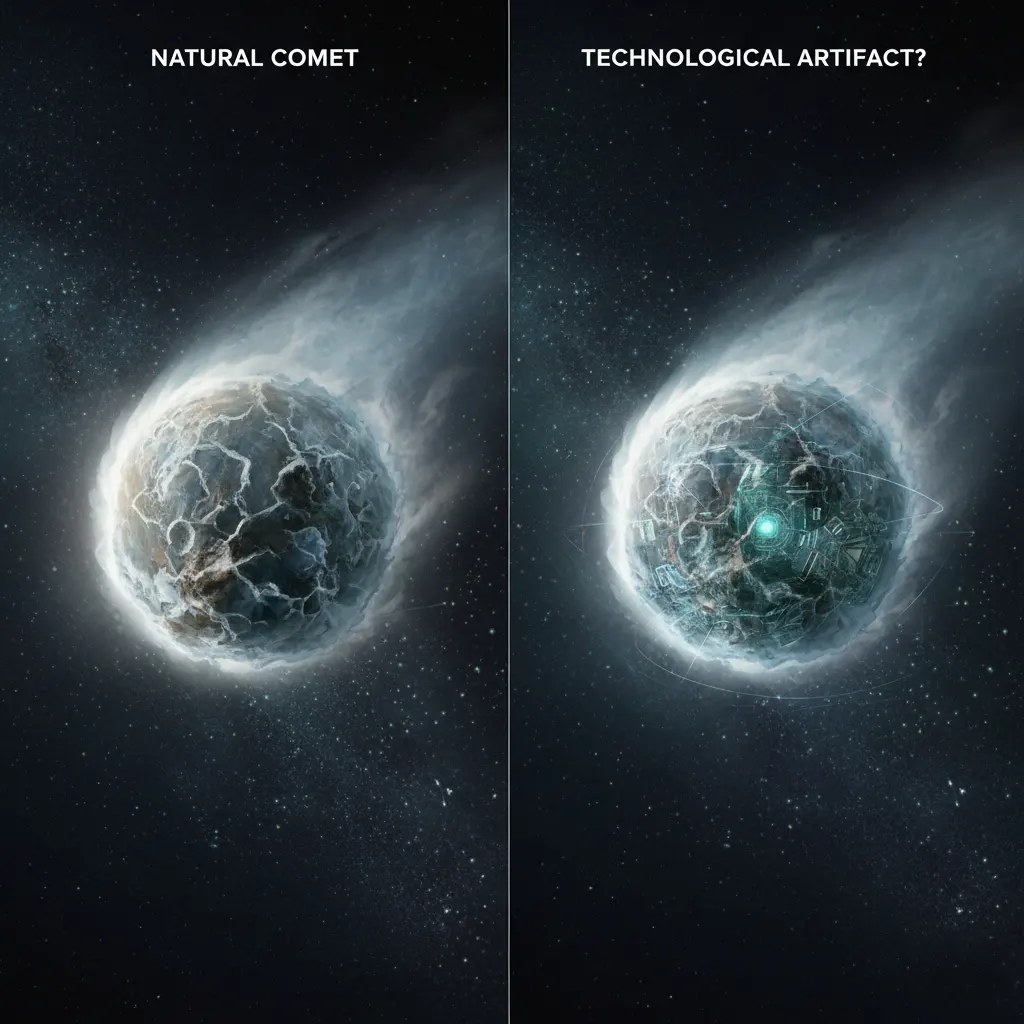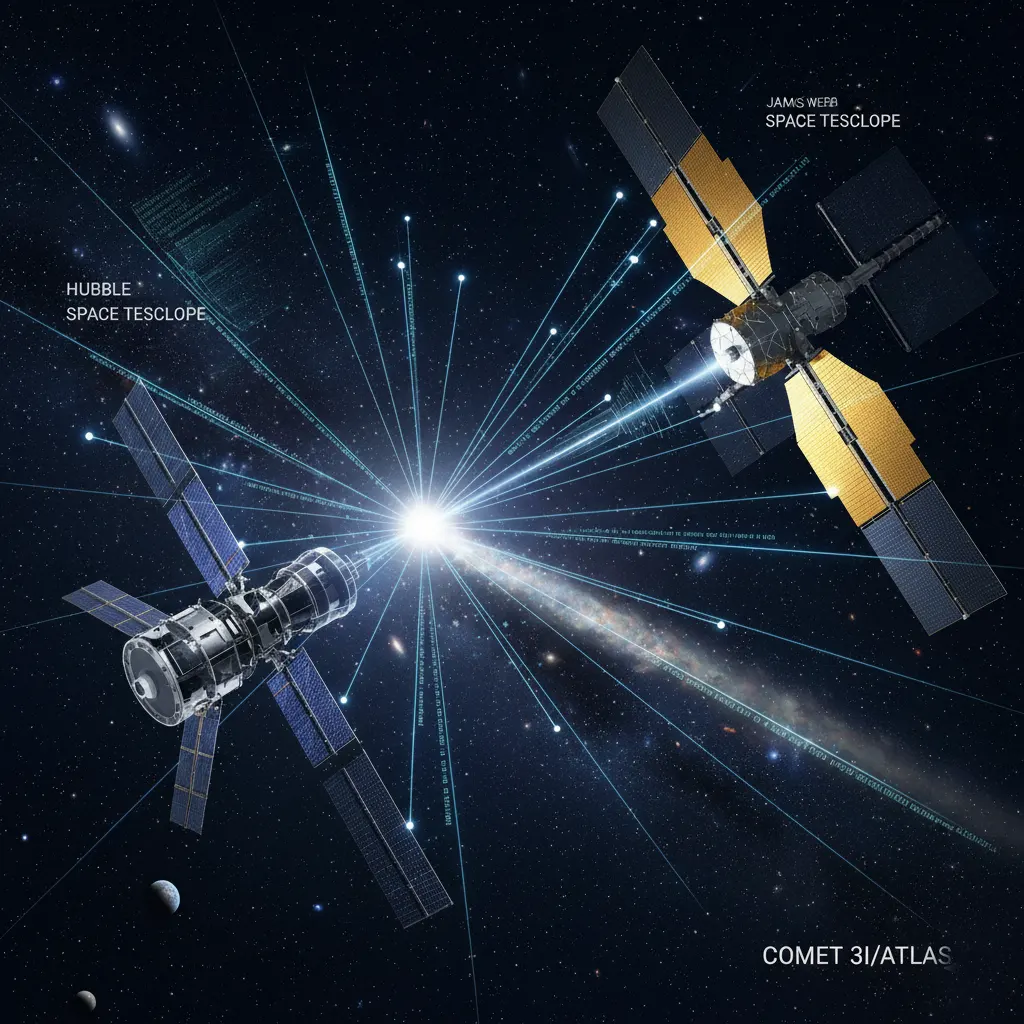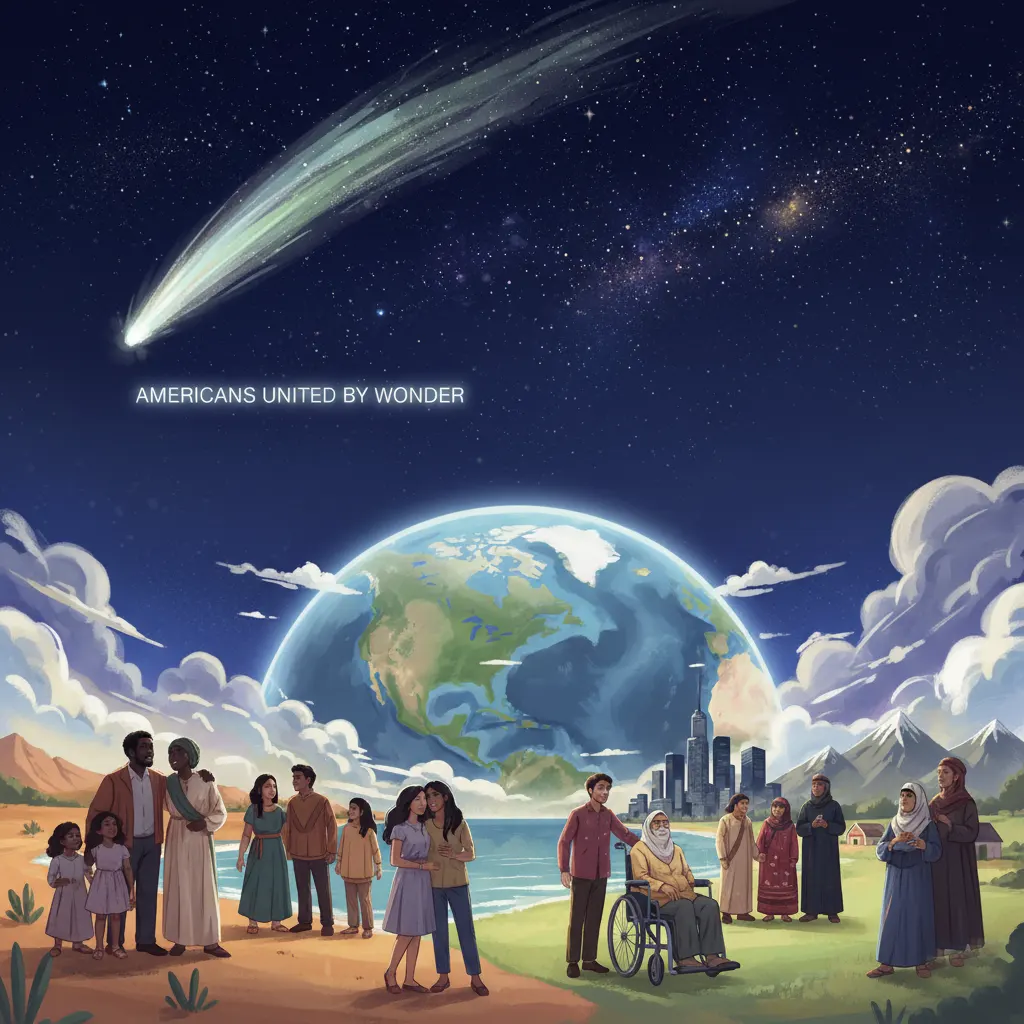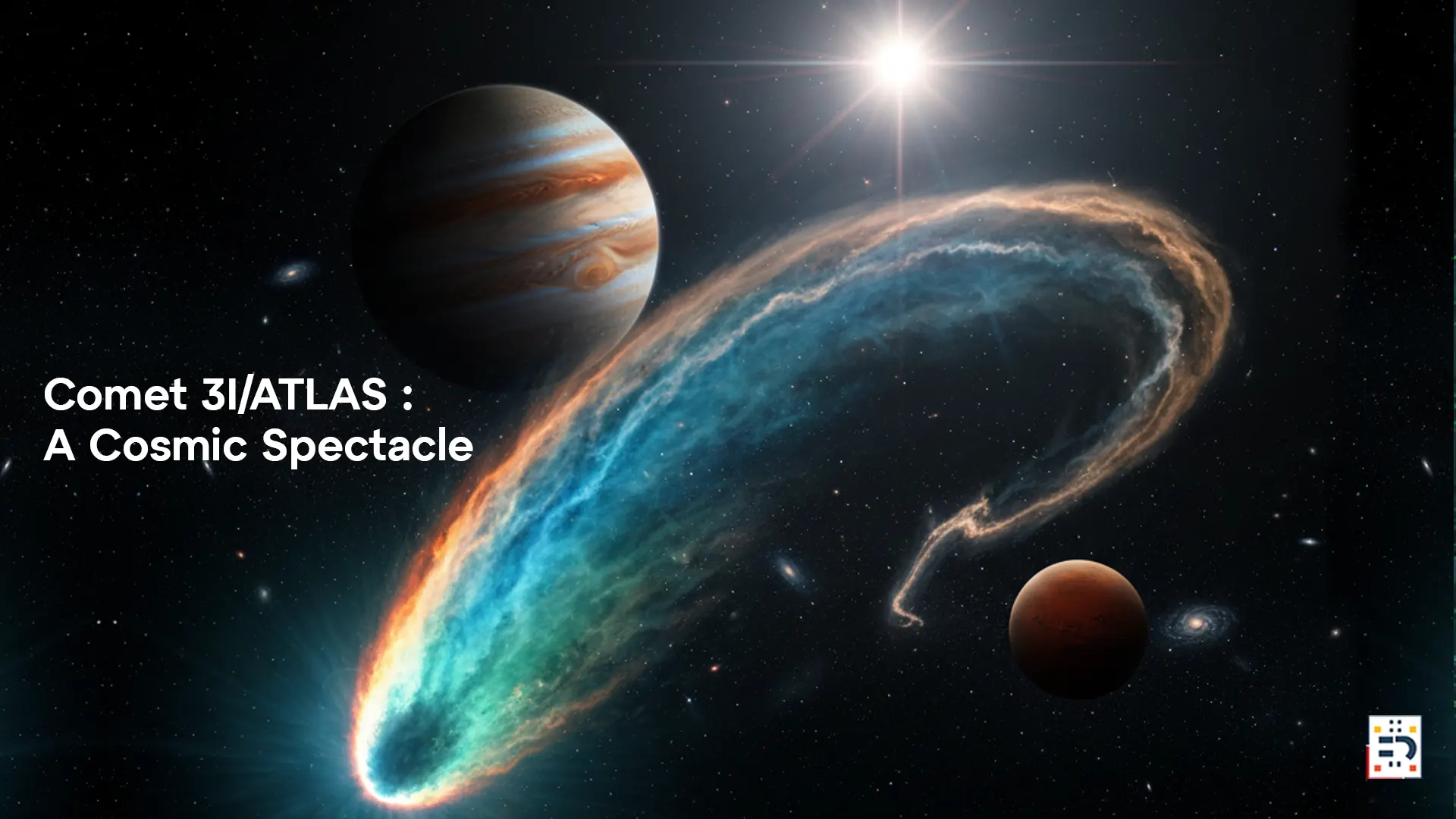The Cosmic Mystery Unfolding Right Now
October 29, 2025 — Today marks a historic moment in space exploration and astronomy. As Americans across the United States look to the skies, an enigmatic visitor from beyond our solar system is making its closest approach to the Sun, hidden from Earth’s view. This object, known as Comet 3I/ATLAS, has sparked one of the most intense scientific debates in recent astronomical history.
Is this interstellar comet simply a natural object from another star system? Or could it be something far more extraordinary—an alien spacecraft using our Sun for navigation?
The question has captured the imagination of space enthusiasts across America, from amateur astronomers in California to NASA scientists in Washington D.C., and has become one of the most trending space topics in the United States this fall.
What is 3I/ATLAS? The Third Interstellar Visitor
Discovery and Classification
On July 1, 2025, the NASA-funded Asteroid Terrestrial-impact Last Alert System (ATLAS) survey telescope in Chile detected an unusual object racing through space at 137,000 miles per hour. Within days, astronomers confirmed what many had hoped for but few expected: this was an interstellar object—only the third ever discovered passing through our solar system.
Following ‘Oumuamua in 2017 and 2I/Borisov in 2019, Comet 3I/ATLAS (designated C/2025 N1) represents a rare opportunity for scientists to study material from distant planetary systems.
Key Facts About 3I/ATLAS:
- Discovery Date: July 1, 2025
- Location: Discovered by ATLAS telescope in Rio Hurtado, Chile
- Speed: 130,000+ mph (209,000 km/h)
- Size: Between 1,444 feet and 3.5 miles in diameter
- Perihelion: October 29, 2025 (TODAY)
- Closest Earth Approach: December 19, 2025
- Distance from Earth: 167 million miles at closest approach
- Threat Level: NO THREAT to Earth

Why Scientists Are Debating This Space Object
The Natural Comet Evidence
NASA’s Hubble Space Telescope captured detailed images showing 3I/ATLAS has a teardrop-shaped cocoon of dust coming off its solid, icy nucleus—a signature characteristic of natural comets. The James Webb Space Telescope observations revealed the comet is wrapped in carbon dioxide fog, consistent with typical comet behavior as it heats up approaching the Sun.
Supporting Natural Origin:
- Visible comet coma (gas and dust cloud)
- Active outgassing consistent with ice sublimation
- Chemical composition includes water, CO2, and carbon monoxide
- Dust tail streaming away from nucleus
- Behavior matches other known comets
The Unusual Characteristics Raising Questions
However, several features have puzzled astronomers and fueled speculation about 3I/ATLAS’s true nature:
1. The Nickel Mystery
Observations from the Very Large Telescope detected unusually high levels of atomic nickel vapor in the comet’s atmosphere. While some nickel exists in natural comets, the abundance detected in 3I/ATLAS has raised eyebrows in the scientific community.
2. Record-Breaking Speed
3I/ATLAS is traveling at 130,000 miles per hour, the highest velocity ever recorded for a solar system visitor. This breathtaking speed suggests the object has been drifting through interstellar space for billions of years.
3. Suspicious Orbital Alignment
The comet’s trajectory brings it close to multiple planets—Venus, Mars, and Jupiter—while maintaining strategic distance from Earth. Its orbit is nearly aligned with the ecliptic plane, the same plane where Earth and other planets orbit.
4. Perfect Timing
The comet reaches perihelion today when it’s completely unobservable from Earth, hidden behind the Sun. This timing means we cannot directly observe what happens during this critical moment.
The Alien Probe Theory: Harvard Scientist Weighs In
Dr. Avi Loeb’s Provocative Hypothesis
Dr. Avi Loeb, the Frank B. Baird Jr. Professor of Science at Harvard University and head of the Galileo Project, has proposed a controversial theory that’s trending across American science circles and social media.
In an appearance on Fox News today, Loeb explained that the fundamental question is whether 3I/ATLAS is a “Trojan Horse” with the external appearance of a natural comet but carrying potential technology in its interior.
The Oberth Maneuver Hypothesis
Loeb suggests 3I/ATLAS could be using today’s perihelion passage to perform what space engineers call an “Oberth maneuver”—exploiting the Sun’s gravitational field to accelerate, decelerate, or release smaller probes toward planets of interest.
Why This Matters:
- Perihelion is the optimal moment for high-energy spacecraft maneuvers
- The physics principle (Oberth effect) states rocket engines generate more energy when fired at higher speeds
- An alien spacecraft would choose this exact moment for trajectory changes
- Earth cannot observe the object during this critical window
The Mini-Probe Scenario
Loeb has pointed out that if 3I/ATLAS were a mothership, it could release mini-probes as small as intercontinental ballistic missiles toward planets in our solar system. These probes would require relatively modest propulsion—around 5 kilometers per second—to reach their targets.
Cosmic Modesty and the Search for Alien Technology
In a recent appearance on the Joe Rogan Experience podcast, Loeb emphasized the need for “cosmic modesty” when examining potential extraterrestrial technology. He argues that humanity’s brief technological history is essentially insignificant compared to the 13.8-billion-year age of the Milky Way galaxy.
“Advanced civilizations could have evolved billions of years before us,” Loeb explained, “and might view humanity as a ‘baby civilization’ worth monitoring from a distance.”

The Scientific Consensus: Why Most Experts Say It’s Natural
Leading Voices in Planetary Science
While Loeb’s theories have captured media attention and public interest across the United States, the overwhelming majority of planetary scientists and astronomers remain unconvinced that 3I/ATLAS is anything other than a natural interstellar comet.
Dr. Darryl Seligman (Michigan State University): While 3I/ATLAS is “hugely exciting,” it’s still fundamentally a natural object.
Dr. Jason Wright (Penn State University): Has argued that Loeb’s claims lack sufficient evidence and that the comet’s peculiarities are not particularly surprising given natural variation in comets from different star systems.
Key Counterarguments to the Alien Hypothesis
- No Non-Gravitational Acceleration
- Careful tracking has revealed no signs of propulsion—the telltale signature of artificial technology
- The comet follows a purely gravitational trajectory within measurement precision limits
- Nickel Occurs Naturally
- Many comets contain trace amounts of various metals, including nickel
- The question is whether 3I/ATLAS’s abundance truly exceeds natural levels
- Peer-reviewed confirmation is still pending
- Expected Variations in Interstellar Objects
- Comets from other star systems should naturally differ from our local comets
- They formed in different environments with different chemical compositions
- These differences help scientists understand how other planetary systems form
- Occam’s Razor
- The simplest explanation—a natural comet—requires fewer assumptions
- Extraordinary claims require extraordinary evidence
- Current evidence doesn’t meet that threshold for most scientists
NASA’s Fleet Tracks the Cosmic Visitor
Multiple Space Telescopes and Missions Observing
NASA has deployed an unprecedented array of space-based and ground-based instruments to study this rare interstellar visitor:
Space Telescopes Currently Observing:
- Hubble Space Telescope — Captured the sharpest images of the comet’s nucleus and coma
- James Webb Space Telescope — Revealed carbon dioxide, water, and carbon monoxide in the coma
- SPHEREx Observatory — Mapped the extensive CO2 gas envelope
- TESS (Transiting Exoplanet Survey Satellite) — Detected early cometary activity in May 2025
Planetary Mission Observations:
- Mars Reconnaissance Orbiter
- ExoMars Trace Gas Orbiter (ESA)
- Mars Express (ESA)
- Perseverance and Curiosity Mars rovers
- Europa Clipper — May detect ion tail particles in late October/early November
- Juno at Jupiter — Will observe in March 2026
- Parker Solar Probe
- Juice Mission (ESA) — Scheduled observations in November 2025
What Happens Next: The Critical Observation Windows
November 2025: Post-Perihelion Analysis
Once 3I/ATLAS emerges from behind the Sun in early November, telescopes worldwide will immediately examine whether its trajectory has changed. This is the moment of truth for Loeb’s hypothesis.
What Scientists Will Look For:
- Any unexpected acceleration or deceleration
- Trajectory changes inconsistent with gravitational forces
- Signs of fragmentation or unusual behavior
- New jets or outbursts indicating internal activity
December 19, 2025: Closest Approach to Earth
Mark your calendars! On December 19—six days before Christmas—3I/ATLAS will reach its nearest point to Earth at approximately 167 million miles. Loeb’s Galileo Project team is monitoring Earth’s atmosphere for any unusual anomalous objects during this period.
This will be the best opportunity for American amateur astronomers with powerful telescopes to potentially glimpse this cosmic visitor, though it will still require professional-grade equipment.
March 16, 2026: Jupiter Encounter
3I/ATLAS will pass within 54 million kilometers of Jupiter, where NASA’s Juno spacecraft could potentially use its radio antenna to search for any artificial transmissions—a definitive technosignature if detected.
The Mass Loss Mystery and What It Reveals
Shedding Material Like All Comets
Analysis shows the comet has lost approximately 2 million tons of material between July and October 2025—about 0.005% of its total estimated mass. This mass loss is consistent with solar heating and natural sublimation of ice.
What This Means:
- The surface layer ablation amounts to only 4 centimeters from a 5-kilometer object
- Comparable to removing the thickness of a human palm from Manhattan Island
- We cannot definitively determine the object’s interior nature from surface observations alone
- Any theoretical technology could be shielded beneath the natural comet exterior
This uncertainty is precisely what fuels Loeb’s “Trojan Horse” hypothesis—the idea that advanced technology could be concealed beneath a natural-looking icy exterior.
The Government Shutdown Complication
Adding an unusual dimension to this unfolding story, NASA is currently closed due to a lapse in government funding, with agency communications going unmonitored. When major news outlets reached out to NASA for official comments on 3I/ATLAS, they received automated responses stating the agency is not monitoring communications during the shutdown.
However, Loeb has publicly dismissed conspiracy theories about the government hiding information, calling any communication delays “a signature of terrestrial stupidity” rather than extraterrestrial intelligence.
This government shutdown has complicated coordination for some observation efforts, though most scientific instruments continue operating autonomously.
Why Interstellar Objects Matter for Space Exploration
A New Frontier in Astronomy and Astrobiology
Whether 3I/ATLAS is natural or artificial, scientists agree it represents an invaluable opportunity. Interstellar objects allow us to study materials from other star systems that would take our spacecraft millions to billions of years to reach.
Revolutionary Scientific Opportunities:
- Understanding Planetary Formation
- Chemical signatures reveal conditions in distant star systems
- Composition differences inform planet formation theories
- Each visitor adds data to our galactic database
- Astrobiology Potential
- Could carry organic molecules or building blocks of life
- Sample return missions could revolutionize our understanding
- Direct evidence of biochemistry from other stellar neighborhoods
- Technology Detection Methods
- Establishes protocols for identifying artificial objects
- Refines our search for extraterrestrial intelligence (SETI)
- Prepares humanity for potential contact scenarios
- Future Mission Planning
- The ESA’s Comet Interceptor mission, scheduled for launch in 2029, will wait in orbit ready to intercept future interstellar visitors
- Recent studies show that flyby missions to interstellar objects are “feasible and affordable” with current technology

The Broader Context: Are We Being Monitored?
The Quasi-Moon 2025 PN7 Connection
In a fascinating coincidence, astronomers recently discovered a quasi-moon designated 2025 PN7 that has been temporarily captured by Earth’s gravity. Loeb is investigating whether this object, too, might be an artificial monitor rather than a natural asteroid—though again, most scientists favor natural explanations.
The Voyager Precedent
As Loeb frequently points out, humans have already sent interstellar probes. Both Voyager 1 and Voyager 2 have officially left our solar system, and Pioneer 10 and 11 are not far behind. If humanity can launch galactic explorers, why couldn’t an advanced civilization?
USA Public Interest and Trending Topics
Social Media Buzz and American Fascination
The 3I/ATLAS story has captured American public imagination, trending across:
- Twitter/X science communities
- Reddit astronomy and space exploration forums
- YouTube space channels with millions of views
- TikTok educational content creators
- Major news networks from CNN to Fox News
Why Americans Care:
- Touches on fundamental questions about humanity’s place in the universe
- Combines cutting-edge science with the possibility of alien contact
- Involves prestigious American institutions (Harvard, NASA)
- Accessible story that anyone can follow in real-time
- Critical observation windows coincide with holidays (Christmas approach)
Educational Impact Across the USA
From classrooms in Texas to planetariums in New York, 3I/ATLAS has become a teaching moment:
- Science teachers using the story to explain orbital mechanics
- Amateur astronomy clubs hosting observation events
- STEM programs leveraging public interest
- Space camps and science museums featuring special exhibits
Expert Opinions: The Scientific Debate
The Case FOR Considering Alien Technology
Dr. Avi Loeb (Harvard University):
- “Science is guided by evidence, not expectations”
- We should remain open to extraordinary possibilities
- Cosmic modesty demands we don’t assume humanity is special
- The timing and characteristics warrant serious investigation
- Better to investigate and be wrong than ignore and miss something historic
The Case AGAINST the Alien Hypothesis
Mainstream Scientific Consensus:
- No direct evidence of artificial propulsion or transmissions
- All observed characteristics can be explained naturally
- Extraordinary claims require extraordinary evidence
- The “peculiarities” aren’t actually that unusual
- Interstellar comets should naturally differ from local ones
- Publication in peer-reviewed journals pending for many claims
How to Follow the Story: Resources for Americans
Official Sources
- NASA’s 3I/ATLAS Page — Official updates and mission observations
- European Space Agency 3I/ATLAS FAQ — European mission updates
- Hubble Mission Updates — Latest telescope observations
- Dr. Avi Loeb’s Medium Blog — Regular updates from the leading proponent of investigation
Real-Time Tracking
- TheSkyLive 3I/ATLAS Tracker — Live position and observational data
- NASA Eyes on the Solar System — Interactive 3D visualization
- Virtual Telescope Project — Regular observation sessions
News and Analysis
- Space.com Comet Coverage — Comprehensive articles and updates
- NASA Spaceflight Forum — Community discussion and expert analysis
- Sky & Telescope Magazine — Professional astronomical perspective
- Scientific American — In-depth science journalism
The Verdict: What’s Most Likely?
Scientific Probability Assessment
Based on current evidence and expert consensus:
Most Likely Scenario (95%+ probability): 3I/ATLAS is a natural interstellar comet from another star system, carrying precious information about planet formation in a distant corner of our galaxy. Its “unusual” characteristics reflect natural variation in comets formed under different conditions.
Possible but Unlikely (4-5% probability): The object exhibits some truly anomalous behavior that current science cannot fully explain, warranting further investigation and possibly revision of our understanding of comet physics.
Highly Unlikely (<1% probability): 3I/ATLAS is artificial technology from an extraterrestrial civilization.
Even Loeb himself recently acknowledged that “by far the most likely outcome will be that 3I/ATLAS is a completely natural interstellar object, probably a comet,” while maintaining there’s a 30-40% likelihood of alternative explanations based on its unusual characteristics.
Why This Story Matters Beyond 3I/ATLAS
Changing How We Search for Alien Life
This episode represents an evolution in how humanity approaches the search for extraterrestrial intelligence:
From Radio Signals to Physical Artifacts:
- Traditional SETI focuses on radio telescope searches
- New approach considers physical objects as potential technosignatures
- More mature methodology that doesn’t assume aliens would announce themselves
- Recognizes that evidence might be subtle and ambiguous
Establishing Scientific Protocols:
- How do we distinguish artificial from natural?
- What constitutes sufficient evidence for extraordinary claims?
- How should the scientific community respond to controversial hypotheses?
- Balancing open-mindedness with scientific rigor
Preparing for the Next Visitor
As the Vera C. Rubin Observatory comes online, scientists expect to discover many more interstellar objects, potentially several per year. Each one will be an opportunity to:
- Refine our detection and analysis methods
- Test and improve theoretical models
- Potentially launch intercept missions
- Expand our understanding of the galaxy
Watching and Waiting
As 3I/ATLAS reaches its perihelion today—hidden behind our Sun at a distance of 130 million miles—humanity finds itself in an unusual position. We’re waiting to see if this cosmic visitor will reveal its true nature when it re-emerges in early November.
What We Know:
- This is definitely an interstellar object from beyond our solar system
- It’s traveling faster than any previously observed visitor
- It shows comet-like behavior consistent with natural objects
- Some characteristics are genuinely unusual and worth investigating
- No definitive evidence of artificial technology has been found
What’s Next:
- November observations will show if the trajectory has changed
- December brings the closest approach to Earth
- March 2026 offers the Jupiter flyby opportunity
- The scientific community continues rigorous analysis
The Bigger Picture: Whether 3I/ATLAS is a natural comet or something more extraordinary, it has already accomplished something remarkable: it has reminded us that the universe is vast, strange, and full of mysteries. It has brought together scientists across disciplines, captured public imagination, and pushed the boundaries of what we consider possible.
For Americans watching this story unfold—from amateur astronomers in their backyards to professional scientists at NASA—3I/ATLAS represents something profound: a reminder to keep looking up, keep asking questions, and remain open to the unexpected.
As Dr. Loeb reminds us: “On a blind date of interstellar proportions, we better observe our dating partners rather than be guided by the limited imagination of our fellow script writers in Hollywood.”
The answer is coming. We just need to keep our telescopes pointed at the right spot in the sky and our minds open to whatever the evidence reveals.
Key Takeaways for USA Readers
Safety: 3I/ATLAS poses ZERO threat to Earth—closest approach is 167 million miles away
Observation: Post-perihelion observations in November will be critical for determining its nature
Science: Most scientists (95%+) believe it’s a natural comet, but investigation continues
Significance: Regardless of origin, it’s invaluable for understanding other planetary systems
Future: More interstellar visitors expected as detection technology improves
Education: Excellent opportunity for STEM learning and public engagement with space science
Stay Updated
Follow NASA, ESA, and leading space science organizations for the latest updates as this remarkable story continues to unfold. The universe has a way of surprising us—and 3I/ATLAS may yet have more secrets to reveal.
#3IATLAS #InterstellarComet #AlienProbe #NASA #SpaceNews #Astronomy #AviLoeb #SpaceExploration #CometDiscovery #BreakingSpace #SpaceNewsUSA #NASADiscovery #HarvardScience #TrendingScience


